Menu
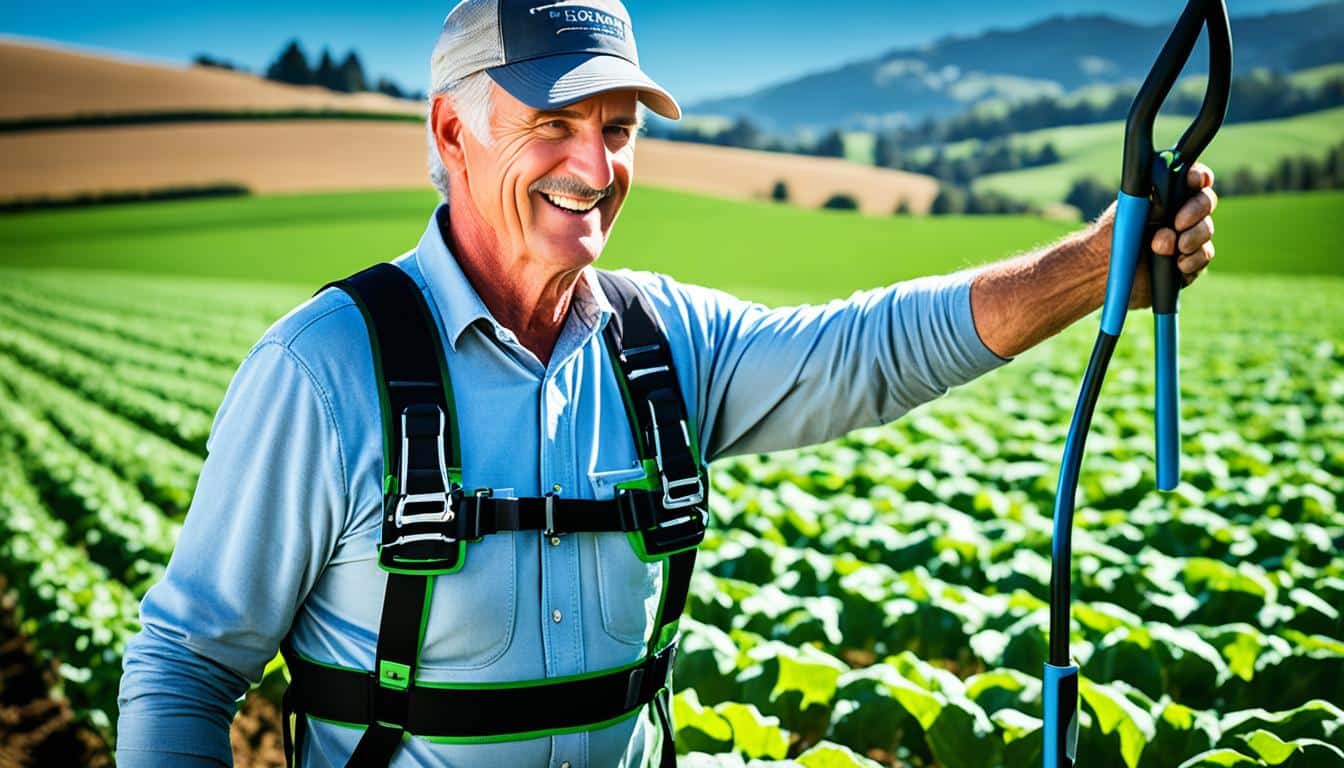
Did you know that 75% of dairy workers get repetitive strain injuries yearly? This info comes from the Upper Midwest Agricultural Safety and Health Center (UMASH). RSIs happen because workers often do the same motions, like milking cows or handling machines.
Mayo Clinic’s Dr. Suzanne Tanner stresses how lifting things badly causes lower back pain. The National Institute for Occupational Safety and Health (NIOSH) points out that farmers often feel pain in their backs, shoulders, arms, and hands.
It’s key to fight back against these issues. To reduce RSI risks, using ergonomic tools and changing work areas can help a lot. Adding variety to tasks, making sure workers take enough breaks, and teaching them the right techniques are also vital.
By using these approaches, we can cut down on injuries in farming. This way, we also keep farmers healthier.
RSIs in agriculture are a big issue. They come from doing the same motions over and over without much rest. Many farm workers get these conditions. Knowing the signs and looking at the numbers helps us see how bad RSIs are for farmers.
RSIs are caused by using the same body parts a lot, which leads to pain and injury. In farming, they happen because of tasks like milking cows, picking crops, and using machines. Bad weather and tiredness make these injuries worse. So, we need to act to stop them.
If someone has RSIs, they might feel pain or discomfort like:
Spotting these signs early and changing how you work can help a lot. It can stop RSIs turning into more serious problems and keep farm workers healthy.
Some stats show how bad RSIs are in farming:
These numbers show we need to do more to keep farm workers safe and working well. Using the right tools and teaching better ways to work are key steps. This can help a lot.
To sum up, we can make a big difference by using better methods to prevent RSIs on farms. This makes life better for those who work in agriculture. Ergonomic tools, mixing up tasks, and teaching how to lift correctly are very important.
It’s vital to know what causes repetitive strain injuries (RSIs) in farming. This knowledge helps make ergonomic solutions that really work for farmers. The hard work in agriculture can put farmers at risk of injuries. So, they should be managed well.
Repetitive motions and overuse cause many RSIs in farming. One study by the Upper Midwest Agricultural Safety and Health Center found that 75% of dairy workers get these injuries every year. Tasks like milking, driving machinery, and picking crops again and again can hurt muscles.

Adopting awkward postures and using too much force are problems too. This happens a lot in farming. Things like bending, turning, and lifting wrong can stress muscles a lot. The National Institute for Occupational Safety and Health says that back pain and pain in the shoulders, arms, and hands are common.
It’s very important to use the right solutions for these problems in farming. Making jobs safer is crucial. This involves dealing with the main causes of RSIs. Then, farming can be safer and last longer.
Repetitive strain injuries (RSIs) cause big problems for those who work in farming. They lead to a lot of physical pain and discomfort. The National Institute for Occupational Safety and Health (NIOSH) says that issues like backaches and pain in the shoulders, arms, and hands are common. These problems can make it hard for farm workers to do their daily jobs well, lowering their wellbeing.
RSIs are very common among farmers, with 75% of dairy workers getting hurt this way every year. Doing things like manual crop harvesting, lifting, and using machinery again and again causes this pain. The pain can become chronic, making it hard for workers to do simple tasks daily. Without proper rest, these injuries just get worse, hurting the workers’ health even more.
RSIs also have a big effect on the money side for both farm workers and their bosses. Workers may earn less if they can’t work as efficiently due to pain or if they become disabled long-term. This can make health issues a big financial worry for farm workers.
Employers also face money problems, like lower productivity and paying for replacement workers or compensation. In California, dealing with back injuries in farming costs over $22 million yearly. This shows how important it is to stop these health issues before they happen.
Introducing ergonomic interventions in agriculture is key to making farmers healthier and stopping RSIs. The National Institute for Occupational Safety and Health (NIOSH) found that by looking at tasks, adding protections, and letting farmers have enough breaks, we can cut down on injuries. Back, shoulder, arm, and hand pains are the usual problems.
Studies say that 75% of dairy folks get hurt from doing the same moves every year, as per the Upper Midwest Agricultural Safety and Health Center (UMASH). So, it’s vital to use farm safety measures such as better tools and work areas. These might be things like dollies to move stuff without lifting, or mats that make it less tiring to stand a lot.
Other than that, offering adjustable surfaces and special platforms for dairy workers can be a big help. Devices like dip cups can stop workers from over-bending and stretching, cutting down on back and shoulder issues.
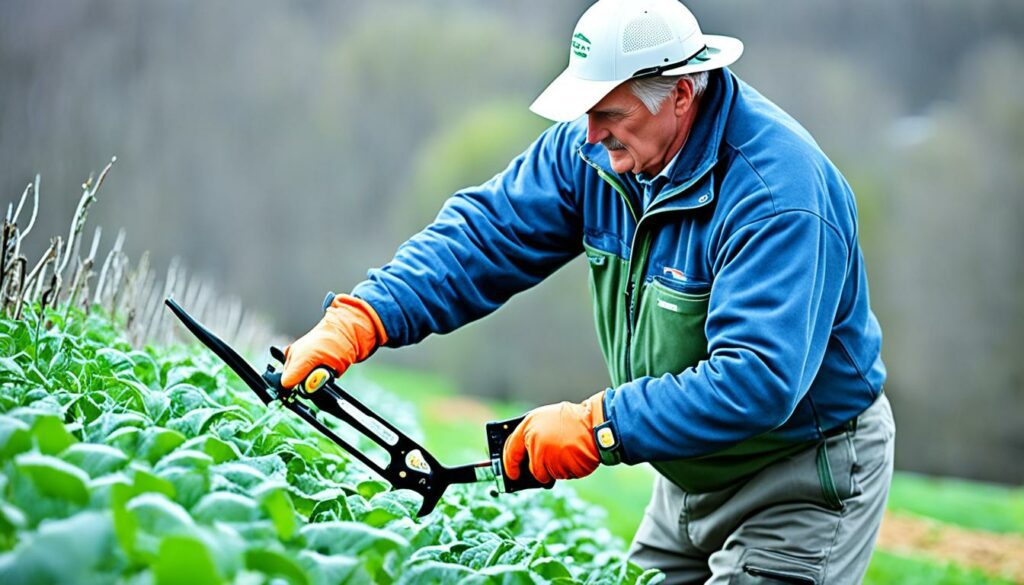
Improving the way farmers work with better tools and spaces helps them stay well and work harder. This not only makes them feel more comfortable but also drops the number of injuries, great for keeping farming going strong. For example, in California, just the costs for workers who hurt their backs could go over $22 million a year. This shows how important good ergonomic solutions are for farming.
To stop RSIs in farming, it’s key to mix tasks, take enough breaks, and learn proper lifting. These steps lower the risk of getting hurt.
Reducing farm work-related injuries is easier with task rotation. By changing tasks, farmers use different muscles, avoiding strains from repetitive work. Working on machinery then doing some manual tasks cuts the chance of RSIs a lot.
Resting enough between jobs helps fight off tiredness and lets the body heal faster. This stops long-term RSIs by giving farmers’ muscles the time they need to recover. A recent five-year study in Saskatchewan looked at the effect of breaks on farm workers’ health. This study wants to see if getting help quickly when hurt can stop future injuries.
Teaching farmers how to lift things safely is crucial. This training helps avoid low back pain and other injuries. Easy steps can make a big difference in keeping farmers safe from RSIs. The NIOSH says back pain is one of the top RSIs among farmers. This makes learning how to lift right very important for reducing farm work-related injuries.
| Preventive Measures | Benefits |
|---|---|
| Task Rotation | Engages different muscle groups, reducing the risk of overuse |
| Recovery Periods | Mitigates fatigue and promotes muscle recovery |
| Proper Lifting Techniques | Prevents low back strain and related injuries |
Using ergonomic farming tools daily boosts health and work results. These tools cut down body strain, which stops injuries. They also make life easier for farmers.
Ergonomic tools have many good points. They lower chances of RSIs and make work more comfy. They also stop long-term health problems. Well-made tools keep you safe when doing things like gripping or squatting.
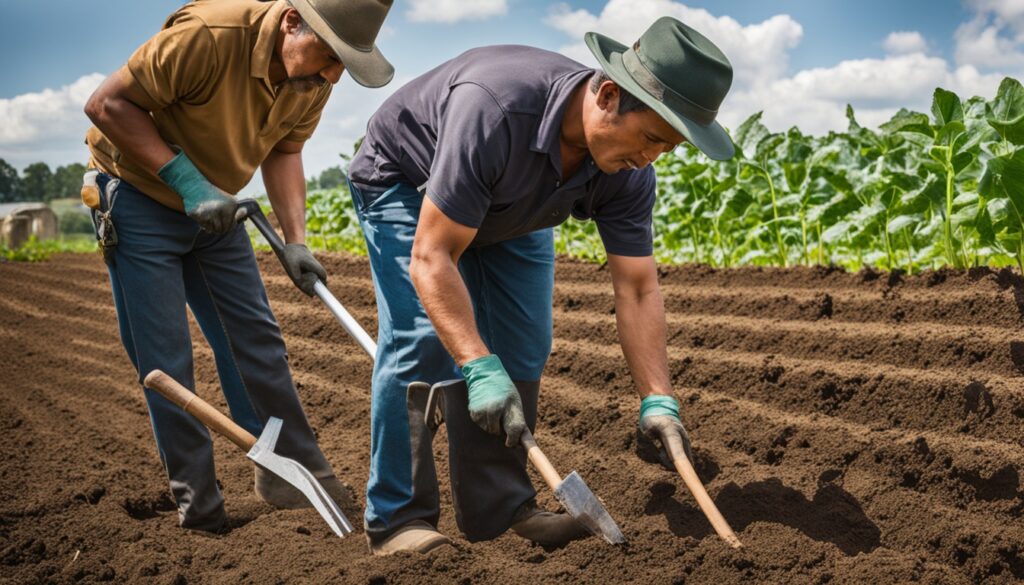
There are many ergonomic tools out there, like:
It’s important to find the right ergonomic tools for RSI prevention. You can get these tools from special shops, farm supply stores, and online. They even come with advice or can be custom made to fit you better, all to stop RSIs.
| Tool | Function | Supplier |
|---|---|---|
| Angled Plant Stand | Reduces bending and reaching | Farming Equipment Direct |
| Cushioned Handles | Prevents hand strain | Ergonomic Tools Plus |
| Lift-Assist Devices | Reduces lifting injuries | Heavy Load Solutions |
| Slip-Resistant Grips | Ensures secure handling | Secure Handlers Inc. |
| Platforms for Dairy Workers | Avoids overhead reaching | Dairy Solutions Ltd. |
| Anti-Fatigue Flooring Pads | Prevents prolonged standing injuries | Comfort Mats Online |
Programs like those by UMASH stress how important ergonomic tools are. They help lower the risk of WMSDs, the top cause of working years’ disability.
To keep farm jobs safe, we must change how work areas are set up. Making work areas better can make farm work both easier and safer. This means setting up work areas in a way that helps farmers keep their bodies in good shape.
Work areas need to fit the tasks and the people doing them. Adjusting the height of tables and seats helps. This stops farmers from having to twist or reach too much.
Avoiding these awkward movements keeps bodies working well. It also means farmers are less likely to get hurt. Using tables and chairs that can change helps each farmer find a comfortable setup.
Anti-fatigue mats are great for hard, cold floors often found in farming. Standing for a long time on these surfaces can hurt. But, these special mats make standing easier by making your leg muscles move. This helps blood flow better, making tiredness less likely. So, using these mats can make farm work more pleasant and productive.
Ergonomics is vital in agriculture. Designing workspaces and tools to keep workers healthy and work well. The right tools can make farm work easier on the body.
Changing work areas can make farm work not just safer but also more efficient. By spending on good work areas and changes, we cut down on injuries in farming.
Understanding the value of rest and recovery stops farmers from getting hurt. Adequate rest for farm workers is a must. It helps them stay healthy and avoid getting too tired.
Adding breaks in repetitive work is key. NIOSH says, taking breaks helps muscles recover, reducing fatigue. It prevents injuries and keeps workers in top shape. For instance, dairy workers often hurt themselves doing the same motions over, and over, needing rest.

Regular days off are crucial too. Working non-stop can lead to injuries. Many farmers keep working even when hurt. This hides how bad their injuries are. But, by taking scheduled rest days, they can heal properly. This stops the problem of doing too much and shows how important it is to rest.
Taking both short breaks during work and regular rest days is a strong way to avoid injuries. Focus on these methods keeps farmers healthier. It fights off repetitive strain injuries effectively.
Adding yoga and stretching to farm routines brings big benefits. They stop muscle imbalances and lower injury risks. Farmers keep their strength and flexibility up, which they need for tough farm work.
Yoga is great for keeping farmers safe. It improves balance, flexibility, and reduces stress. It also helps muscles get less tight from working again and again. Yoga can cut down on injuries like RSIs by making muscles work better.
Simple stretches can also help a lot. Do them 2-3 times a week for the best results. Remember, stretching isn’t warming up. It’s best done after a light walk. Make sure it feels good and not painful.
Basic stretches prevent muscle strains and tiredness. Breathe normally when you stretch. It makes your body perform better. Here are some good stretches to do:
In the end, yoga and stretching are vital for farmers. They prevent injuries and make you feel better in body and mind. Keep up with these exercises regularly to stay healthy and work well on the farm.
Making farms safer involves many steps. One key part is checking and making changes to the tools and how we work. The UMASH says 75% of dairy workers get hurt every year doing the same movements over and over. This shows changing how we work can be very important.

NIOSH points out that many farmers get hurt from doing the same movements over and over. This can include backaches, shoulder pain, and issues with hands and arms. Using special tools and spaces can make these jobs less risky. For example, platforms for dairy workers and special dip cups can help a lot.
A solid farm safety plan should focus on preventing injuries from doing the same movements often. Tools that help, like dollies and pallet trucks, are very useful. Also, using pads that reduce tiredness and slipping can make a big difference.
These actions make work safer, improve how well things are done, and look after the team’s health.
NIOSH warns that simple, regular movements can badly hurt farm workers. So, being smart about how we work is really important.
Following these steps, farming can be safer for everyone. It means learning more about safety, using the right tools, and making sure health and safety come first.
Engaging farmers in learning about RSIs tackles a big issue: the risk of repetitive strain injuries in farming. They learn through workshops and safety training. This knowledge helps them use ergonomic principles. As a result, they cut down on musculoskeletal disorders.
Farmers get to know about RSIs in these workshops and programmes. They learn to spot strain early and stop it before it gets worse. They get hands-on with safe lifting and how to use tools properly.
The need for this learning is clear. A lot of farm injuries that end in hospital visits are sprains and back issues. The cost of handling these injuries runs high, especially for back problems in California.
Besides face-to-face learning, farmers can use online guides to keep up safe practices. They learn ways to make work areas better and how to use tools that fit well. The Canadian Centre for Health and Safety in Agriculture has lots of useful info too.
Farmers can find these guides on educational sites or safety pages. The tips in them help farmers check and improve their workplace health. For example, using the right tools can make tasks easier and lessen the chance of getting hurt.
A study in Saskatchewan shows how key this is. Looking at how jobs are done and the setup of work areas helps to avoid bad injuries. Combining on-site training and online help really makes a difference. It makes farming safer and more efficient.
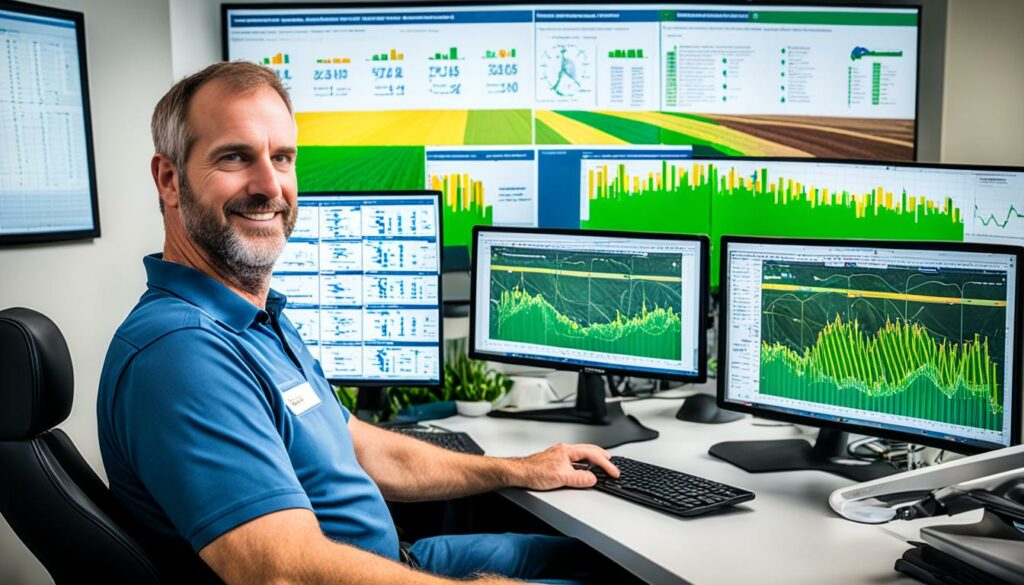
It’s vital to check on workplace ergonomics regularly. This helps spot problems and find ways to make work safer. By looking closely at how people work and what tools they use, we can make their jobs better fit their needs.
In farming, it’s about looking at how work gets done. We zoom in on tasks that put bodies at risk. Things like bending in funny ways, doing the same movements over and over, and using too much force. These are common reasons people get sore and hurt. By keeping an eye on all this, farms can change things up. They make jobs easier on the body. This cuts down on how often people get hurt.
Studies from NASD show that changing how people work can make a big difference. It means the job suits the worker better. This keeps people safe, comfortable, and working well.
Getting feedback from workers is key. After making changes, hearing what they think is important. This ‘check and adjust’ process keeps work spaces safe and comfy.
Feedback helps fine-tune what’s been changed. For example, adjusting the height of a desk or how tools are used. Following the right guidelines, like not lifting too high, can really help. It makes life better for workers and boosts how much they can get done.
| Type of Injury | Annual Occurrences | Associated Costs |
|---|---|---|
| Back Injuries | 3,000+ | $22 million+ |
| Sprains and Strains | One-third of all injuries | Significant impact on earnings |
Farmers can prevent RSI with a mix of strategies, including changes in how work is done. Case studies on RSI prevention show what works. They share useful tips and real-life stories.
Success stories exist in farm safety. For instance, a poultry plant in France cut injuries by making work easier. They focused on better body positions. This approach is also seen in meat factories, which report fewer injuries thanks to smarter work areas.
In Brazil and England, farms have seen success by improving the work environment. They use things like softer floor mats and better work heights. These changes make work more comfortable and reduce injuries. They show how important effective measures are across farming types.
These studies offer important advice for everyone in farming. They suggest changing tasks and taking regular breaks. They also mention using better tools. These simple steps can make a big difference. They point to the need for careful setup and smart planning.
Using these stories as a guide, farms can make their working conditions safer. This not only keeps workers happy but also boosts their productivity.
Here’s a detailed table showcasing comparative insights from these successful case studies:
| Farm Location | Intervention | Outcome |
|---|---|---|
| France | Ergonomic programme in poultry processing | Reduction in cumulative trauma disorders |
| England | Optimised workstation design | Fewer musculoskeletal injuries |
| Brazil | Height-adjustable work surfaces | Increased employee comfort and reduced injury rates |
By looking at these successful farm safety measures and learning from ergonomic interventions, farms can do better in preventing RSI. This leads to healthier and happier workers.
Participatory ergonomic programmes are key in tackling work-related injuries in farming. In 2020, Korea found that 5.0% of farmers had work injuries, with a huge 84.6% due to musculoskeletal issues. These programmes work best when farm workers are part of developing and putting them in place.
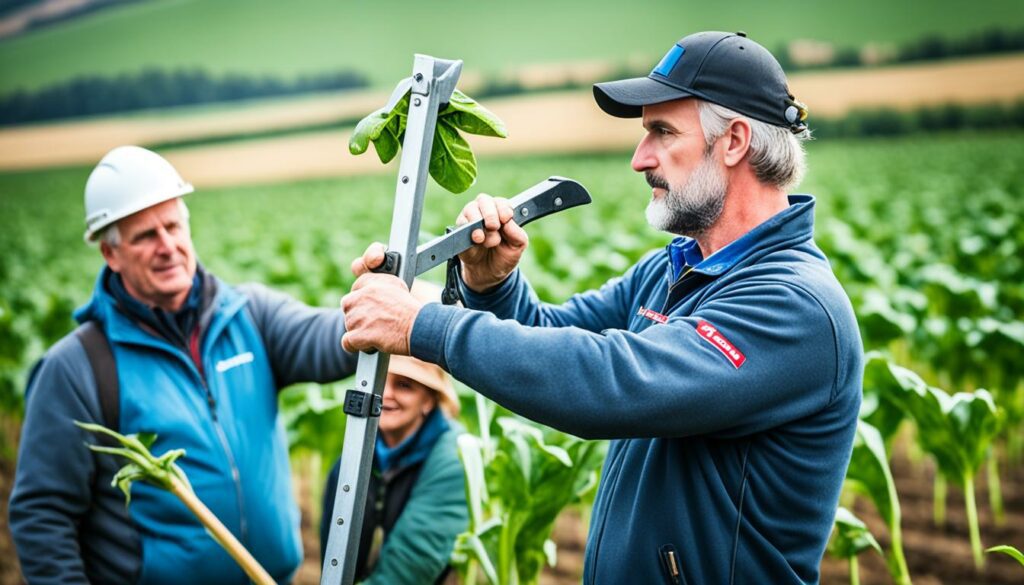
Getting farm workers involved boosts the success of these efforts. Their knowledge and feedback help find risks and match solutions to real work needs. Harvesting is a good example, as it causes many work injuries due to actions like repeated bending.
Working together, farm workers and ergonomics experts understand and apply better ways to work. This partnership reduces strain injuries and makes workers feel more responsible for a safe workplace.
These farming efforts have been so good that other fields, like mining and healthcare, have used them too. This has led to fewer injuries. So, it’s important to help farm workers share their ideas. Doing so makes sure the solutions are useable and work well.
In ending, keeping farm workers safe from RSI needs a full plan. This situation is serious because back pain affects about 80% of Americans. It’s a big issue in agriculture since it’s the top reason for disability in young adults.
Farmers face a lot of risk for back pain and muscle injuries. This is due to heavy lifting, dealing with animals, and working on bumpy land. Using the right lifting methods, good seats and tools, it’s possible to lower these dangers. Add in regular exercise, good sitting, and talking to doctors, and you’re looking out for farm workers’ health.
To keep farming safe and free from injury, we need to do a few things. Setting up jobs differently, making space for breaks, and using tools that fit well. It’s also smart to let farmers help shape how to keep their work safe. Doing all this means working in a place that’s caring and helps everyone stay healthy.
Repetitive strain injuries (RSIs) happen when we do the same movements a lot. This strains our muscles, tendons, and nerves. Not taking enough breaks can make this worse.
Backaches, shoulder pain, and arm and hand discomfort are signs of RSIs. They often point to problems in our muscles and bones.
75% of dairy workers have RSIs each year, says UMASH. Reports from NIOSH show that back and shoulder pain is common in farming.
Doing the same things over and over causes RSIs. Things like awkward postures, too much force, and even the weather can make it worse.
Repeating tasks without rest affects our muscles and bones. This can make them more likely to get hurt. Milking cows and using machines are big examples in farming.
Bad postures and too much force can strain muscles and joints. This can hurt us more and increase the chance of injury.
Extreme weather and long hours can tire our muscles. This makes us more likely to get hurt. Being tired also makes us forget to be careful, adding to the risk.
RSIs can cost farm workers money and health. They might earn less and even get long-term injuries. Employers also pay more for sick leave and replacement workers.
To prevent RSIs, use tools and setups made to fit our bodies. Doing different tasks, taking breaks, and lifting right help too.
By switching what we do, we use different muscles. This helps give a break to the ones we overuse.
Our bodies need time to heal and not get too tired. This stops small injuries from becoming big ones over time.
Use your legs to lift, not your back. Hold heavy things close to you and never twist while lifting. Teaching these methods is key to stopping injuries.
Ergonomic tools make work easier, keep us comfortable, and help prevent long-term harm. They’re made to fit how our bodies move and work.
Angled plant stands, cushioned handles, lift-assist devices, and grippy tools are good examples. They help reduce the stress on our bodies.
You can get these tools from farming suppliers, online shops, and specially designed programs. They offer advice on using and adjusting your equipment too.
Changing how our work areas are set up can stop bad postures. Adding mats can also help lessen how much our bodies ache.
Anti-fatigue mats make standing easier on our bodies. This means we’re less likely to get hurt just by standing for too long.
Taking breaks and days off helps our bodies fix themselves. It stops us from getting too tired and hurt from doing the same things all the time.
Yoga and stretches make our muscles more flexible and less tight from doing the same jobs. Adding these to our routines makes our bodies work better and lowers the chance of injuries.
To be safe, farms should check how we use our tools and dress us in protective gear. This makes our work spaces safer and stops injuries from happening.
Workshops, training online, and guides show us how to work without getting hurt. They teach us about the right tools to use, how to lift safely, and how to not get too tired.
Looking at how we work can show what’s wrong and how to fix it. This way, our jobs get safer over time, making our work easier and less likely to cause harm.
Studies on preventing RSIs show us how to hurt ourselves less and be happier at work. They’re examples for other farms to follow in keeping their workers safe.
Workers helping choose and use tools that fit better stops injuries better. This makes work safer and shows that everyone is working together to prevent harm.